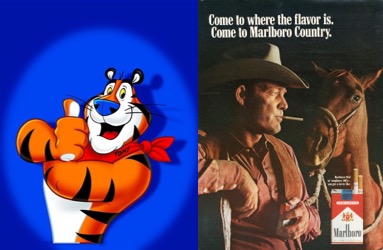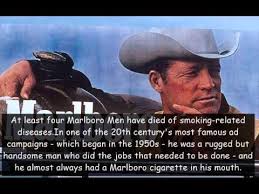 Just a few generations ago, you could say almost anything you wanted in advertising.
Just a few generations ago, you could say almost anything you wanted in advertising.
Kids could “run faster and jump higher” in Keds sneakers. (Check out this 1950’s Keds Ad. You can’t make this stuff up!) Baseball icons Yogi Berra and Mickey Mantle made TV ads for Camel cigarettes that ran during ball games. Fat and sugar laden cake and cookie mixes helped moms bake “wholesome” treats for their families. Sugary cereals – proudly named “Sugar Frosted Flakes,” “Sugar Pops” and “Sugar Smacks” were good-for-you breakfasts. Toys and other products that could seriously hurt toddlers and kids were advertised unchecked.
One of the great heroes of 1950’s and 1960’s TV advertising was the Marlboro Man. He was created in 1954 to make filtered cigarettes, then considered “feminine,” acceptable to men. Creating a macho, freedom loving, horse-riding cowboy who was one with nature in “Marlboro Country” inspired many teenagers and young men to choose this brand of cigarettes in the distinctive red, flip-top box. As smoking was accepted everywhere at the time – in homes, offices, restaurants, airplanes, even doctor’s offices and hospitals – smokers liked to have their cigarettes handy for when the mood struck. It seemed that Marlboro smokers not only wanted their smokes handy, but to display them conspicuously, in their front shirt pockets or rolled up in a t-shirt sleeve, wearing their “badges” proudly and proclaiming their machismo.
We know how that story ended. The Surgeon General linked smoking with cancer, chronic bronchitis, emphysema and heart disease in 1964. It was all downhill for the cigarette industry after that. To add insult to injury, we heard of the actors who portrayed Marlboro Men in advertising, smokers of the product they pitched, dying of cancer.
 Another advertising icon, also created by Leo Burnett, sometimes known as the “Critter” agency for all the characters they created, was Tony the Tiger, famous for his booming bass voice and trademark line, “They’re Grrrrreat!” Unlike the Marlboro Man, Tony lives on, still implying that Frosted Flakes, having dropped the “sugar” qualifier, is still part of a healthy breakfast for active kids.
Another advertising icon, also created by Leo Burnett, sometimes known as the “Critter” agency for all the characters they created, was Tony the Tiger, famous for his booming bass voice and trademark line, “They’re Grrrrreat!” Unlike the Marlboro Man, Tony lives on, still implying that Frosted Flakes, having dropped the “sugar” qualifier, is still part of a healthy breakfast for active kids.
But Tony’s best days may be behind him. Marketing efforts for sugary foods targeted at kids have come under increasing scrutiny in the United States and are now heavily regulated. But could we see all ads for these products – maybe even the products themselves – eventually banned here as well?
A recent New York Times article, In Sweeping War on Obesity, Chile Slays Tony the Tiger, does not bode well.

“They killed Tony the Tiger. They did away with Cheetos’ Chester Cheetah. They banned Kinder Surprise, the chocolate eggs with a hidden toy.
‘The Chilean government, facing skyrocketing rates of obesity, is waging war on unhealthy foods with a phalanx of marketing restrictions, mandatory packaging redesigns and labeling rules aimed at transforming the eating habits of 18 million people.”
Kellogg and Pepsi and Coke can’t be happy about this. But according to the New York Times article:
“Until the late 1980s, malnutrition was widespread among poor Chileans, especially children. Today, three-quarters of adults are overweight or obese, according to the country’s health ministry. Officials have been particularly alarmed by childhood obesity rates that are among the world’s highest, with over half of 6-year-old children overweight or obese.
“In 2016, the medical costs of obesity reached $800 million, or 2.4 percent of all health care spending, a figure that analysts say will reach nearly 4 percent in 2030.”
That’s a real problem. And it’s nearly as bad here. The CDC estimates that 38 percent of adults over 20 are obese, as are 21 percent of adolescents, and 17 percent of kids age 6-11. By some estimates, this costs the U.S. economy nearly $200 billion a year.
But does the crisis in Chile or here in the U.S warrant the iron hand of the nanny state? Shouldn’t people be able to choose whatever they want to eat or drink? Shouldn’t adults take personal responsibility for their own and their children’s health? You’d like to think so, but they don’t. So what about the cost to society?
Whatever you may believe about this issue, politically or philosophically, we clearly see where this is headed. Local governments are beginning to confront the problem in two ways.
First, as we see in Chile, laws are being created to directly limit the appeal and the intake of foods and beverages proven to be unhealthy. This is justified as a means to creating a healthier, happier, more productive citizenry.
Next, those choosing to indulge in “bad” nutritional behavior are being financially penalized. This is already happening in the United States. Cities across the country have enacted a soda tax. In Boulder, Colorado you’ll pay an extra 2 cents per ounce to enjoy your sugary drink. You’ll pay a cent and a half in Philadelphia, and a penny per ounce in Chicago.
Why not, these municipalities reason, discourage their citizens from indulging in unhealthy behaviors while using tax proceeds to fund education, infrastructure or other needs?
If you don’t think that the train has left the station for food and beverage manufacturers here, reflect for a moment on what’s happened to smoking in the past 40 years. As I mentioned earlier, you could once smoke just about anywhere. Now you can smoke almost nowhere.
Someone in my condo association proposed that we ban smoking in our building. Not just in common indoor and outdoor areas, which was never allowed, but in owner’s units, their personal living space, as well. I’m not a smoker, but I argued that if we do that we might as well start monitoring the salt intake of everyone in the building. No one laughed, but the measure didn’t pass. Still, other than private, stand-alone homes, smokers will find it increasingly difficult to find a cozy smoking spot to enjoy their ciggies in peace.
On the pricing front, a standard pack of 20 smokes in the state of California will set you back between 8 or 9 bucks, of which nearly $3.00 is tax. In New York City, you might spend over $10 a pack with city tax thrown in. That’s quite a bit, and while higher than other states, taxes across the country have turned cigarette smoking everywhere into a very expensive habit.
How expensive? According to a Wall Street Journal report, the average price of a pack of cigarettes in 1964 was 30 cents. That would be just $2.37 in today’s dollars!
These laws and levies have had their desired effect. The U.S. Centers for Disease Control and Prevention (CDC) reports that 22 percent of adult men and 18 percent of adult women were regular smokers in the first half of 2010—nearly one-half the rates of the 1960’s when the incidence was 42 percent. Some feel that smoking in the U.S. may be almost non-existent within 30 years.
Initially a habit that denoted wealth and sophistication, smoking now embodies the exact opposite. According to the National Center for Health Statistics, 30 percent of current smokers have only a high school education or less, 21 percent have had some college, and just 9 percent of college grads light up.
At the risk of being politically incorrect, this translates into the upper classes looking down on smoking as a habit for the unenlightened downscale masses. And isn’t the same thing happening in food? Coastal elites enjoy their gluten-free, organic, farm-to-table food while sneering at middle America’s love for Olive Garden and KFC.
It would seem that Frosted Flakes would be less addictive than cigarettes, so you have to wonder how many people will be loading up their grocery carts when it costs $10 a box. And if you’re an eligible single in a big city with a good job who can still afford pricey cereal or a $15 12-pack of Coca-Cola, you’ll have to hide it if you’ve got a date coming over. Profiles on dating sites will soon say “no-soda drinkers” please.
How are marketers of these wholesome turned sinister products respond? Efforts by the soft drink industry touting all they’ve done to reduce sugar, portion sizes and expand into non-sugary drinks seem so insincere. The target for those ads are regulators more than consumers and they aren’t likely to work.
The most recent ad for the beleaguered Diet Coke, under attack not for sugar but its inherent artificiality and perceptions of being unhealthy offers what seems to be a “screw it all” approach.

“It’s delicious! It makes me feel good! Life is short! So just do you, whatever that is. If you you’re in the mood for a Diet Coke, have a Diet Coke! Diet Coke. Because I can.”
Wow. Cue the Libertarians. This is a page out of tobacco marketing. “I’m free and I’ll do whatever the hell I want, consequences be damned.” I’m not sure that a “we’re all going to die anyway” strategy is the right way to go here. But other than setting these products out to pasture as cash cows and focusing on other, healthier products, there appear to be few good choices here.



